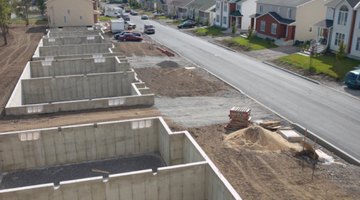How to Connect Wood Floor Joists to a Cinder Block Wall
A traditional cinder block foundation wall or stem wall supports wood floor joists with a simple wood frame. The frame consists of a sill plate anchored to the top of the wall, and a vertically positioned rim joist, also called a “band” joist, nailed to the sill plate.

Things You Will Need
- Tape measure
- Pencil
- Sill plate lumber
- Framing square
- Circular saw
- Power drill
- Wood-boring drill bit
- Adjustable wrench
- Anchor bolt washers and nuts
- Rim joist lumber
- Framing nail gun
- Joist lumber
Once sill plates and rim joists are in place, the builder cuts wood floor joists to size and runs them between the rim joists.
-
Measure across the top of each wall to determine the length of each wall’s sill plate. Mark the length of the sill plate on the sill plate lumber with a pencil and use a framing square to lay out a straight cut across the lumber’s width. Cut the sill plates to size with a circular saw.
-
Measure the positions and spacing of the anchor bolts protruding from the top of each wall with a tape measure. Mark the positions of the anchor bolts on their respective sill plates with a pencil; keep in mind that the outside edge of the plate must be flush with the outside face of the wall. Bore anchor bolt holes at each mark, using a power drill equipped with a wood-boring bit. Lay the sill plates over the bolts and onto the tops of the walls. Place washers and nuts onto each anchor bolt and secure the sill plates to the wall by tightening the bolts with an adjustable wrench.
-
Measure across the installed sill plates to determine the length of the rim joists; the rim joists that will rest perpendicular to the floor joists stretch corner to corner and the rim joists that rest parallel to the floor joists fill the space in between. Mark the determined lengths on the rim joist lumber, use a framing square to lay out a straight cut, and cut the lumber to size with a circular saw.
-
Lift one of the rim joists that will rest perpendicular to the floors joists and place the joist on top of the proper sill plate. Stand the rim joist on edge and position the rim joist’s outside face flush with the outside edge of the sill plate and its ends flush with the ends of the sill plate. Have a partner help you hold the rim joist in position.
-
Use a framing nail gun to toe-nail the rim joist to the sill plate while holding the rim joist in position. Toe-nailing refers to driving a nail through rim joist and into the sill plate at an approximately 30 degree angle. Although specific nail sizing and pattern varies according to building design and code requirements, rim joist must connect to the sill plate at least at each end and every 16 inches or 24 inches on center, according the to spacing of floor joists. Lift, position and toe-nail the remaining rim joists. Use a nail gun to connect the the rim joists at each corner; drive nails through a rim joist's face into the butt of the adjacent rim joist.
-
Mark the position of floor joists on the inside face of the rim joists with a tape measure, pencil and framing square; remember, the floor joists connect to the rim joists that run from corner to corner of the cinder block wall. Refer to your blueprints or local building codes for floor joist spacing, typically 16 inches or 24 inches on center. Measure the distance between the opposite rim joists to determine the length of a floor joist. Lay out the measurement on a piece of floor joist lumber and cut to size with a circular saw.
-
Hoist the cut floor joist between the rim joists, resting the piece on top of the sill plate. Align the floor joist with the layout lines that indicate its position, and use the framing nail gun to end-nail the floor joist to the rim joist. End-nailing refers to nailing through the outside face of the rim joist and into the end of the floor joist. Measure, cut and install the remaining floor joists.
Tip
Use sill sealer and flashing to protect sill plates from rot and pests, if applicable.
Warning
Always consult your local building authority, an architect or engineer to determine acceptable design, lumber dimensions, nail sizing and spacing.
References
Writer Bio
Based in Hawaii, Shane Grey began writing professionally in 2004. He draws on his construction experience to write instructional home and garden articles. In addition to freelance work, Grey has held a position as an in-house copywriter for an online retailer. He holds a Bachelor of Arts in theater arts from Humboldt State University.
Photo Credits
- Hemera Technologies/AbleStock.com/Getty Images
- Hemera Technologies/AbleStock.com/Getty Images
More Articles



